Ramen revival: Regional flavours from Osaka to Niigata, $3.90 hawker options, S’pore-style noodles
Sign up now: Get ST's newsletters delivered to your inbox

(Clockwise from top left) Tokusei Karashibi Miso Ramen and Niku-Niku Karashibi Miso Ramen from Kikanbo; Next Shikaku’s Slow-cooked Oyster Broth “Koeru”; Ginger Shoyu Ramen With Special Topping and Hakata Tonkotsu Ramen from Ramen Soshiji; and Black Tiger Prawn Tempura, Signature Tonkotsu Ramen and Abura Dry Ramen from hawker stall Uma Haus.
PHOTOS: CHONG JUN LIANG, LIM YAOHUI, ACREATIVEALT, HEDY KHOO
Follow topic:
- Singapore's ramen scene is revitalised with authentic regional Japanese flavours and local innovations in 2025. Diners seek craft, quality and unique stories.
- New brands like Kikanbo (spicy ramen) and Next Shikaku (oyster ramen) join established names, catering to Singaporeans craving authentic Japanese tastes.
- Homegrown ventures such as Uma Haus and Ramen Story add Singaporean twists to ramen, offering affordable and fusion-style options like Abura Dry Ramen.
AI generated
SINGAPORE – Ramen is back in the spotlight as new and established brands serve regional flavours from Japan, while local players add their own spin to the bowl.
When China-based restaurateur Ma Qing, 39, decided to bring two Japanese ramen brands to Singapore, his goal was to showcase contrasting expressions of Japanese noodle culture.
His company, First Frontier Food, operates Kikanbo from Tokyo and Next Shikaku from Osaka.
“Each brand represents very different aspects of Japanese ramen culture,” he says.
“Kikanbo focuses on fiery bowls with bold spiciness and a numbing sensation, while Next Shikaku highlights ramen in lighter, oyster-based broths. By introducing both, we can offer Singapore diners more variety and depth in experiencing authentic ramen.”
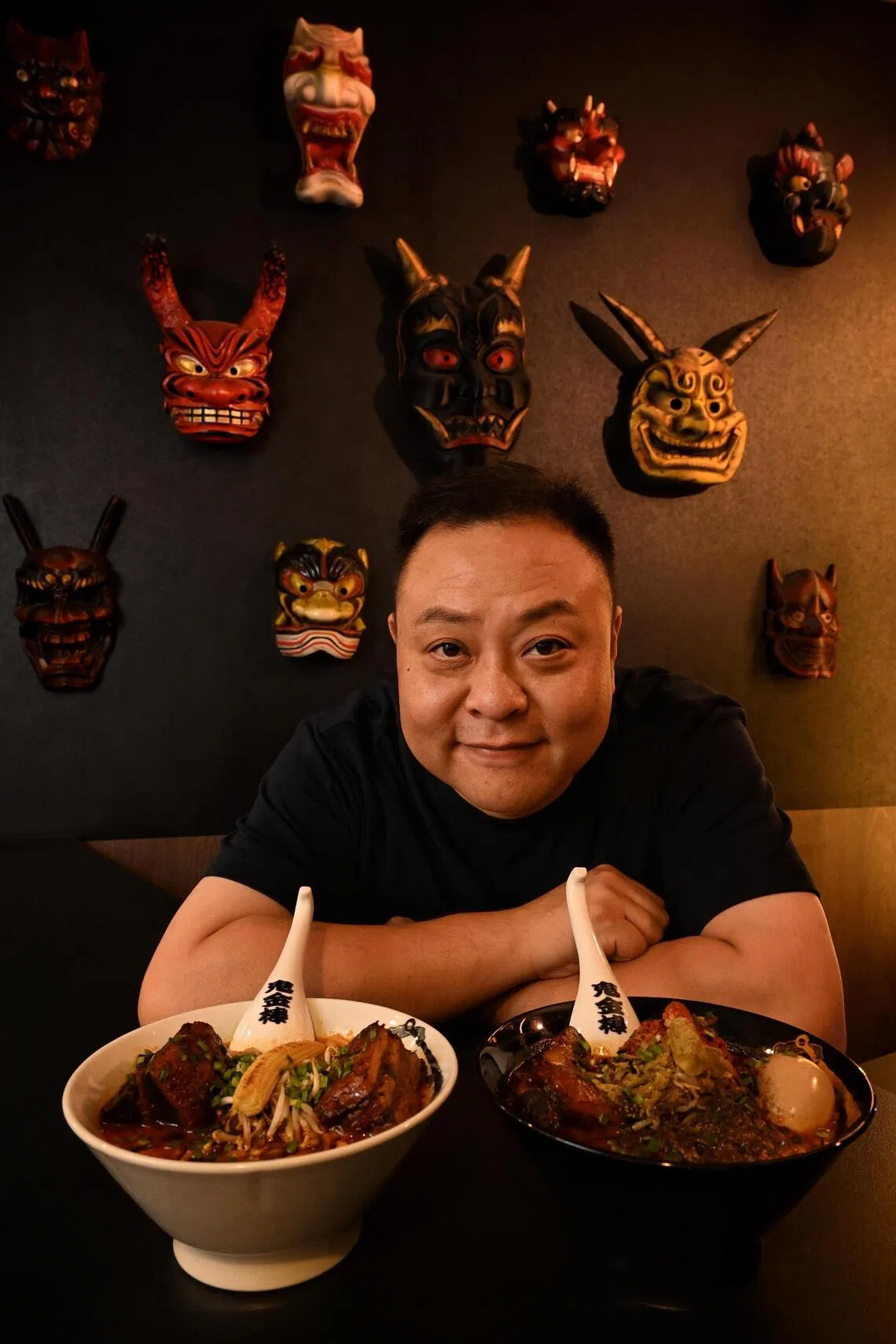
Mr Ma Qing is the owner and director of First Frontier Food, which owns the Singapore franchise for Tokyo ramen restaurant Kikanbo. His company also brought in Osaka ramen brand Next Shikaku.
ST PHOTO: CHONG JUN LIANG
Ramen itself is hardly new here, but it has regained momentum in 2025.
Chef Tomoharu Shono, the 45-year-old founder of Mensho Tokyo and Mensho X, says: “Around early 2025, we began to feel the renewed energy. Compared with previous years, today’s ramen trend is more design-driven and ingredient-conscious.
“People care not just about taste, but also the story behind the dish, sustainability and the overall dining experience. People are looking for comfort food that is familiar and elevated. Ramen fits that perfectly. It’s accessible, yet can also be deeply creative.”
He adds: “Competition is positive, it pushes everyone to improve. For Mensho, it motivates us to go deeper into quality and innovation. Competition raises the overall standard of the industry and I am open to it.”
Industry players say one reason driving the trend is growing demand from Singaporeans who crave the authentic regional styles of ramen they enjoyed during their travels in Japan.
At Orchard Plaza, Ramen Soshiji, helmed by Niigata-born chef Takashi Hashimoto, 54, specialises in Ginger Shoyu Ramen ($13.80+), a speciality of Nagaoka City in Niigata. The broth is fragrant with ginger and blended soya sauce.
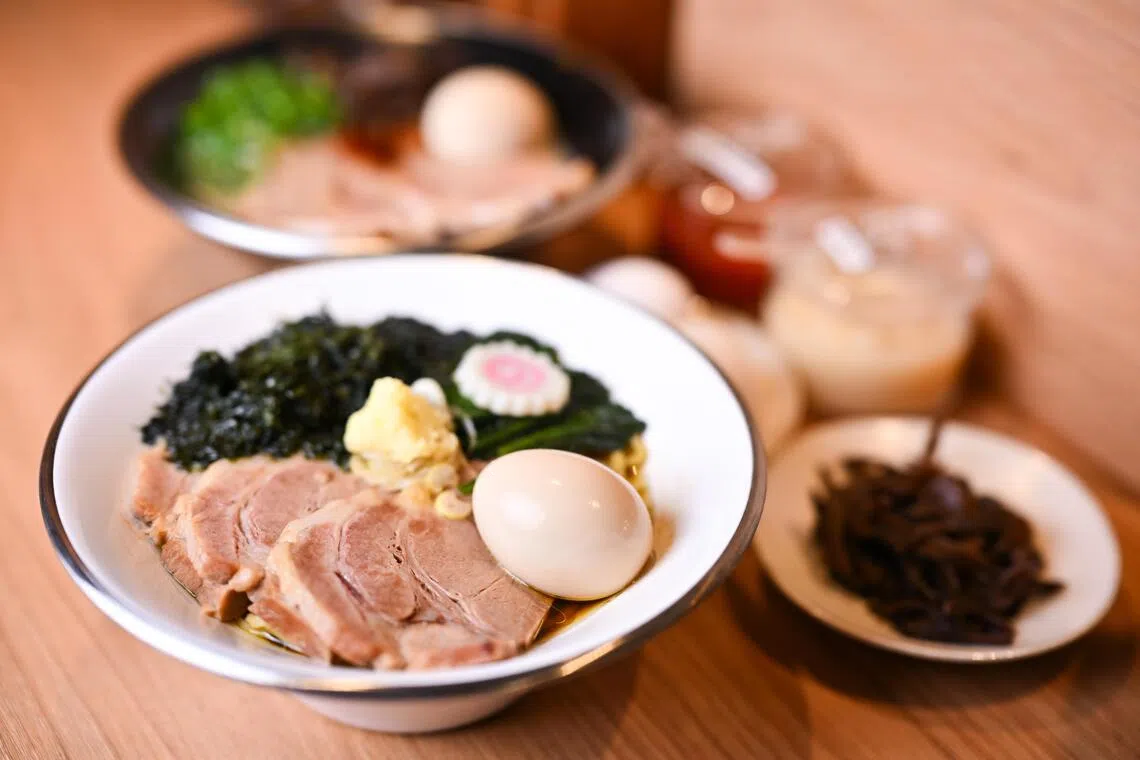
Ginger Shoyu Ramen With Special Topping at Ramen Soshiji at Orchard Plaza.
ST PHOTO: LIM YAOHUI
Next Shikaku serves ramen in broths simmered from fresh oysters in a 28-seat space at Westgate mall.
Existing brands are expanding too.
Sanpoutei Ramen – which is from Niigata and opened its first two Singapore outposts in 2014 at Holland Village and Shaw House – launched its third outlet at Paragon in May.
Meanwhile, Mensho Tokyo’s fast-casual offshoot, Mensho X, which launched in July 2025 in Battery Road, unveils its second outlet at Weave at Resorts World Sentosa on Nov 1, debuting new dishes such as mochimen noodles, which have a soft, chewy texture.

Mensho X at Weave at Resorts World Sentosa is the ramen brand's second outlet.
PHOTO: MENSHO X
Even home-grown ventures are adding a local twist.
Hawker stall Uma Haus – run by Mr Tang Gim Meng, 54, formerly a head chef at a Japanese restaurant – offers Abura Dry Ramen from $3.90. And fast-casual eatery Ramen Story By Jinggho Shokudo – led by Mr Alexander Kong, 34 – blends Japanese techniques and premium ingredients with Singapore-style noodles.
Ramen’s latest rise is not about novelty, but a return to craft, flavour and regional roots. From Tokyo to Niigata and from oyster-rich broths to local hawker renditions, these seven ramen shops show how Singapore’s appetite for the Japanese noodle keeps growing.
Kikanbo: Fiery numbing ramen from Tokyo
Where: B2-36 VivoCity, 1 HarbourFront Walk @kikanbo.sg
Open: 11am to 10pm daily
Info: Call 6592-2616;
Known for its spicy, numbing ramen, Kikanbo, which means demon’s iron club in Japanese, opened in Tokyo in 2009 as a small counter-style shop. The concept, which has two outlets in the Japanese capital, opened in Singapore at VivoCity on Sept 7.

Kikanbo is known for its spicy, numbing ramen.
ST PHOTO: CHONG JUN LIANG
The signature soup combines two broths for greater depth of flavour. One is made from pork bones, chicken bones, vegetables and spices simmered for more than 10 hours, and the other is a seafood stock of sardines and bonito flakes for added richness.
The fiery effect comes from red peppers, while sansho (Japanese pepper) and Sichuan pepper create a distinctive tingling finish.
Shinshu miso (yellow miso) – which is fermented longer than white miso – adds a deep savoury note when blended with peanut paste, fish sauce and spices. Each bowl is topped with stir-fried bean sprouts and baby corn, with a standout being the star anise-flavoured braised pork belly, slow-cooked for up to 20 hours until tender.
Diners can choose from five levels of spiciness and five levels of numbing heat, ranging from non-spicy to the ultimate Oni (demon) level.
The best-selling Niku-Niku Karashibi Miso Ramen ($22.90+) features a double portion of braised pork belly in a rich miso broth.
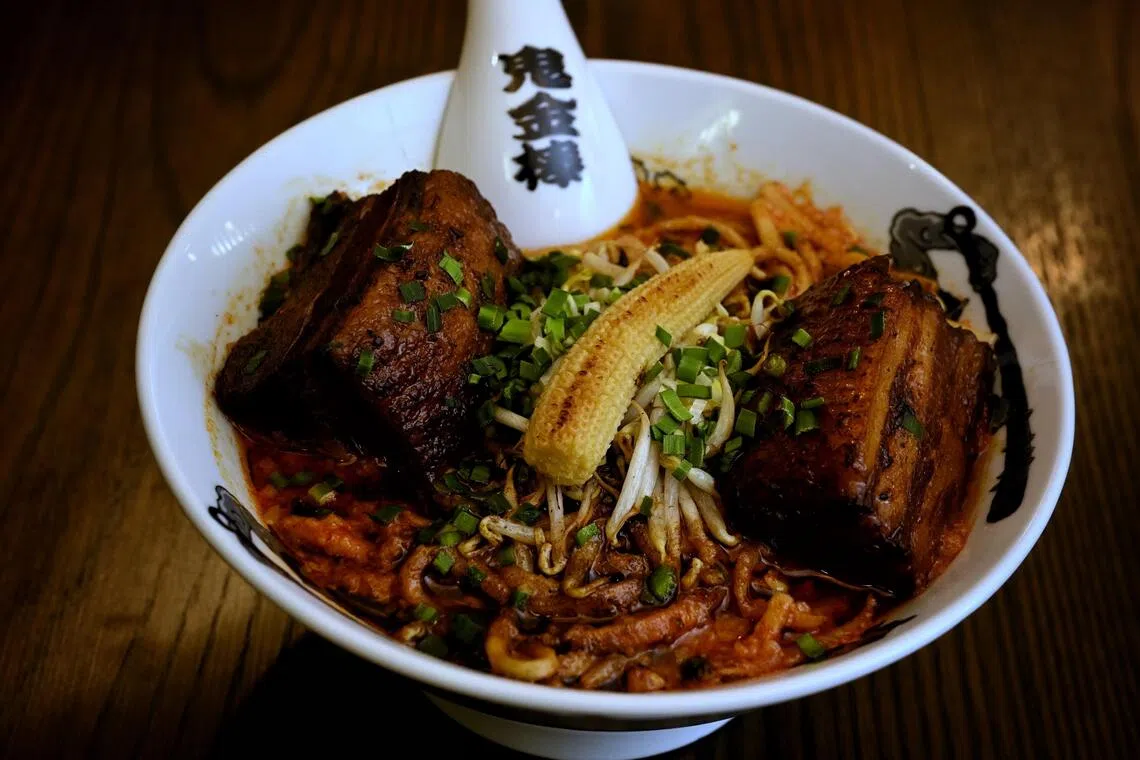
Niku-Niku Karashibi Miso Ramen is a bestseller at Kikanbo ramen restaurant.
ST PHOTO: CHONG JUN LIANG
The Tokusei Karashibi Miso Ramen ($20.90+) offers the full Kikanbo experience with a drizzle of spicy and numbing oils.
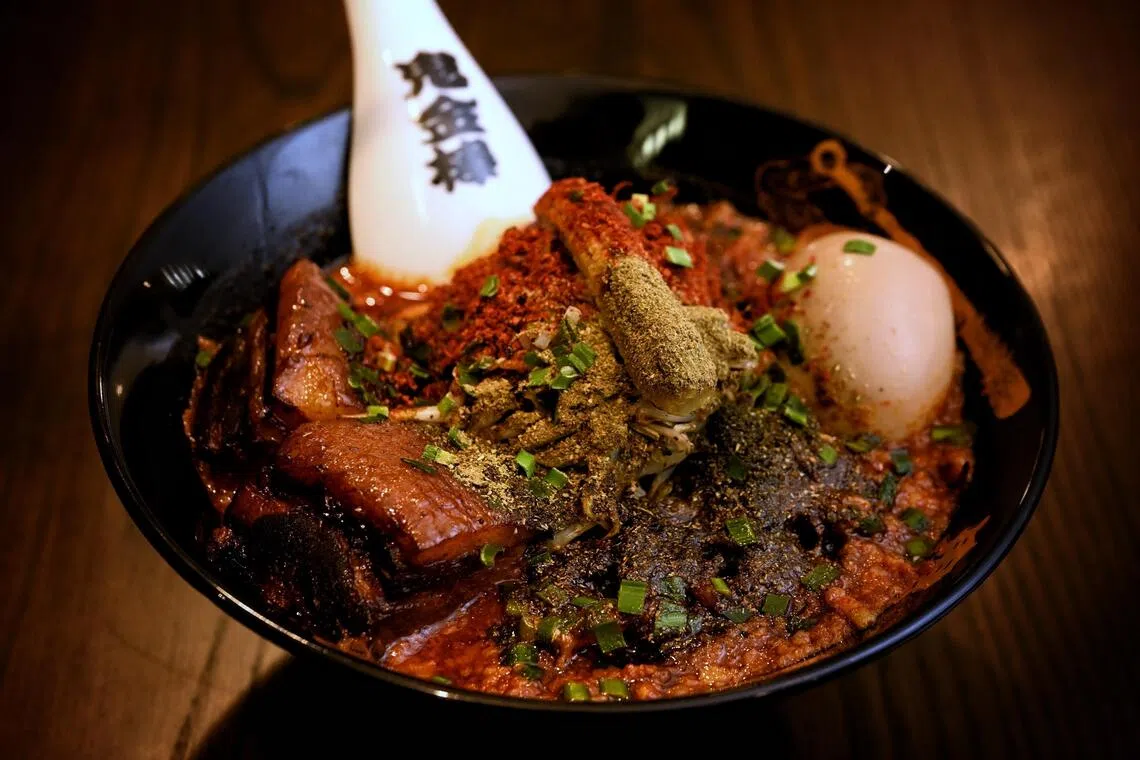
Tokusei Karashibi Miso Ramen from Kikanbo.
ST PHOTO: CHONG JUN LIANG
Next Shikaku: Osaka-style oyster ramen
Where: B1-28 Westgate, 3 Gateway Drive @nextshikaku_s g
Open: 11am to 10pm daily
Info: Call 6592-5060;
Opened at Westgate in December 2024, Next Shikaku, a ramen concept from Osaka, specialises in slow-cooked oyster ramen. The original outlet in Osaka opened in August 2021 and there is another outpost in Hong Kong.
“We wanted to introduce a unique style of ramen that stands out for its texture and flavour,” says Mr Ma Qing of First Frontier Food, a food and beverage company which owns the Singapore franchise for Next Shikaku.
“Osaka-style ramen is creative and experimental, and using oysters brings a balance of intensity and elegance.”
Unlike other ramen styles, which use pork or chicken bones to make the stock, Next Shikaku uses fresh oysters as a key ingredient.
Each bowl features freshly made noodles with a firm bite that hold up against the rich oyster broth. The Slow-cooked Oyster Broth “Koeru” Special ($20.90+) is the top seller, made from a triple broth blend of fresh oysters, chicken and pork. The result is a creamy, layered broth served with thick, chewy noodles and a hint of lime for brightness.
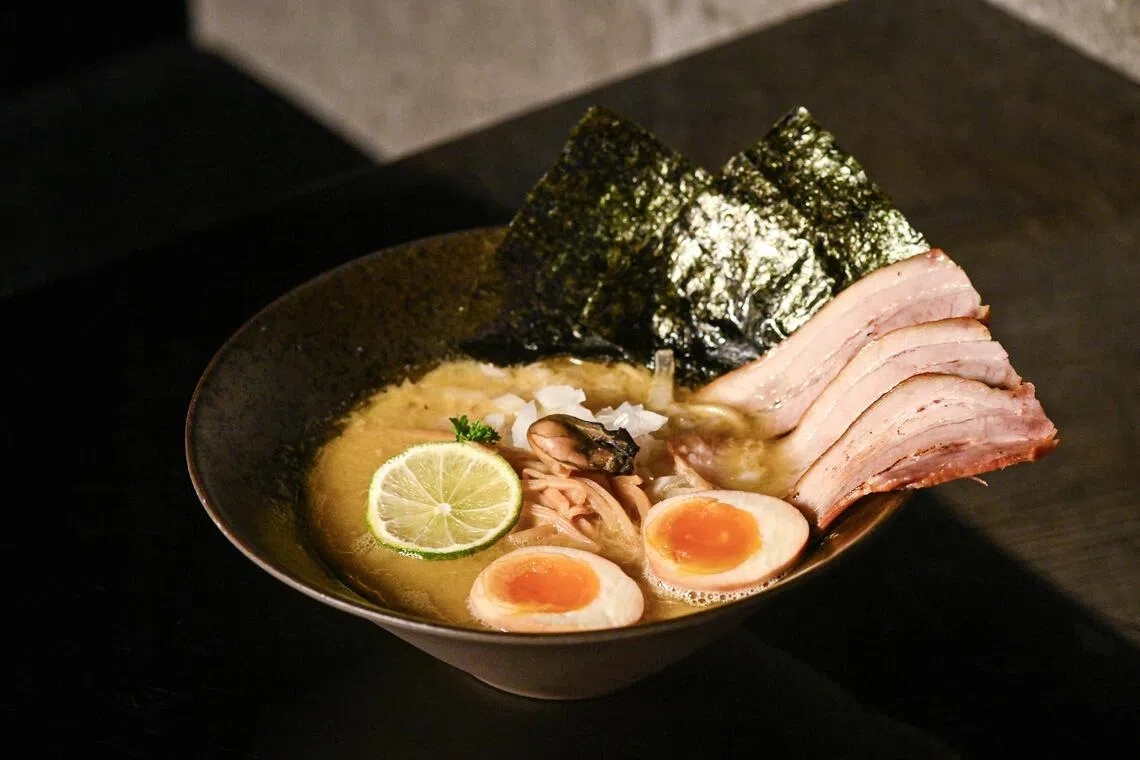
Next Shikaku’s Slow-cooked Oyster Broth “Koeru” Special is made from fresh oysters, chicken and pork.
PHOTO: ACREATIVEALT
Also worth trying is the Oyster Tsukemen “Asobu” Special ($22.90+), featuring cold dipping noodles that are thick and wide, and a warm oyster-based broth accented with lemon zest and grilled pork slices. It delivers a clean, oceanic finish that shows how ramen can be comforting and modern.

The Oyster Tsukemen “Asobu” Special at Next Shikaku features cold, thick dipping noodles served separately from a warm oyster-based dipping broth.
PHOTO: ACREATIVEALT
Ramen Soshiji: Flavours of Niigata and beyond
Where: 03-42 Orchard Plaza, 150 Orchard Road @ramen_soshiji.sg
Open: 6 to 11.30pm, Tuesdays; noon to 2pm and 6 to 11.30pm, Wednesdays to Saturdays; noon to 2pm and 6 to 10pm, Sundays; closed on Mondays
Info:
It was while working at a yakiniku restaurant at Cuppage Terrace that Niigata-born chef Takashi Hashimoto had the idea of starting a ramen shop in Singapore.
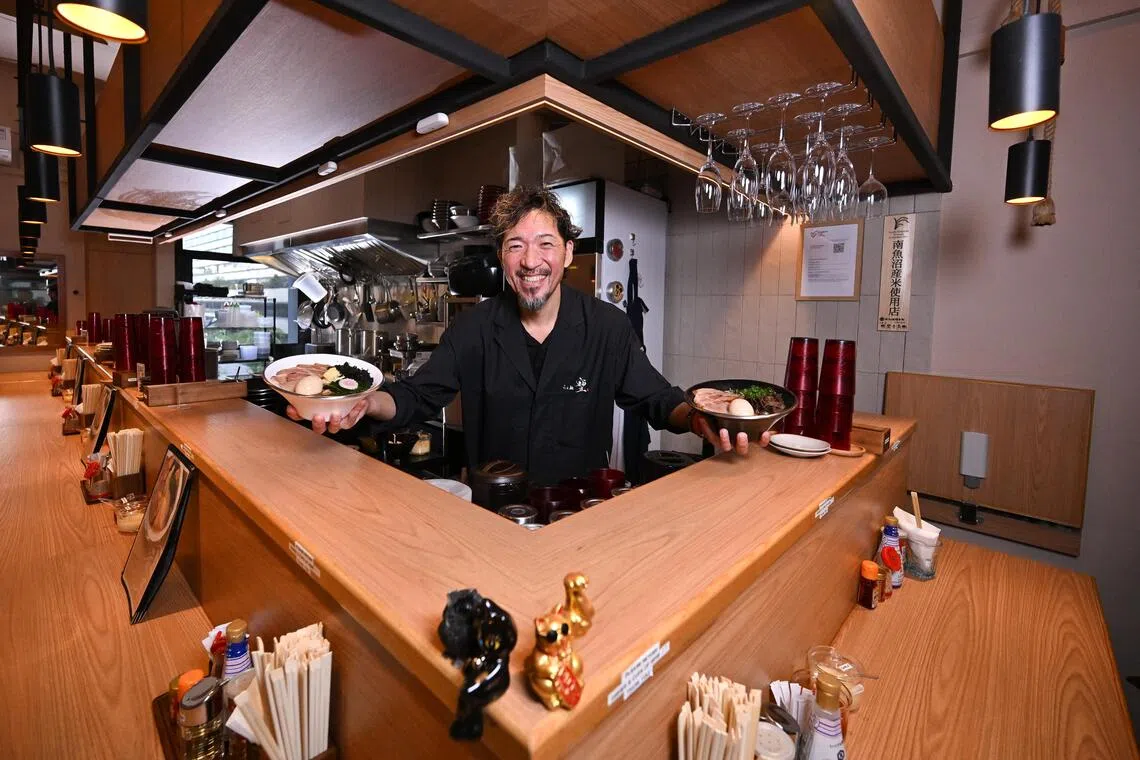
Co-owner and chef Takashi Hashimoto opened Ramen Soshiji, which quickly drew a following with its Niigata-style ramen.
ST PHOTO: LIM YAOHUI
The 54-year-old had cut his teeth at Sanpoutei in Niigata for more than 15 years before moving to Singapore to work at its Shaw House outlet in 2014. Three years later, he joined Yakiniku Jan Jan, where regulars familiar with his ramen background began requesting off-menu bowls after midnight.
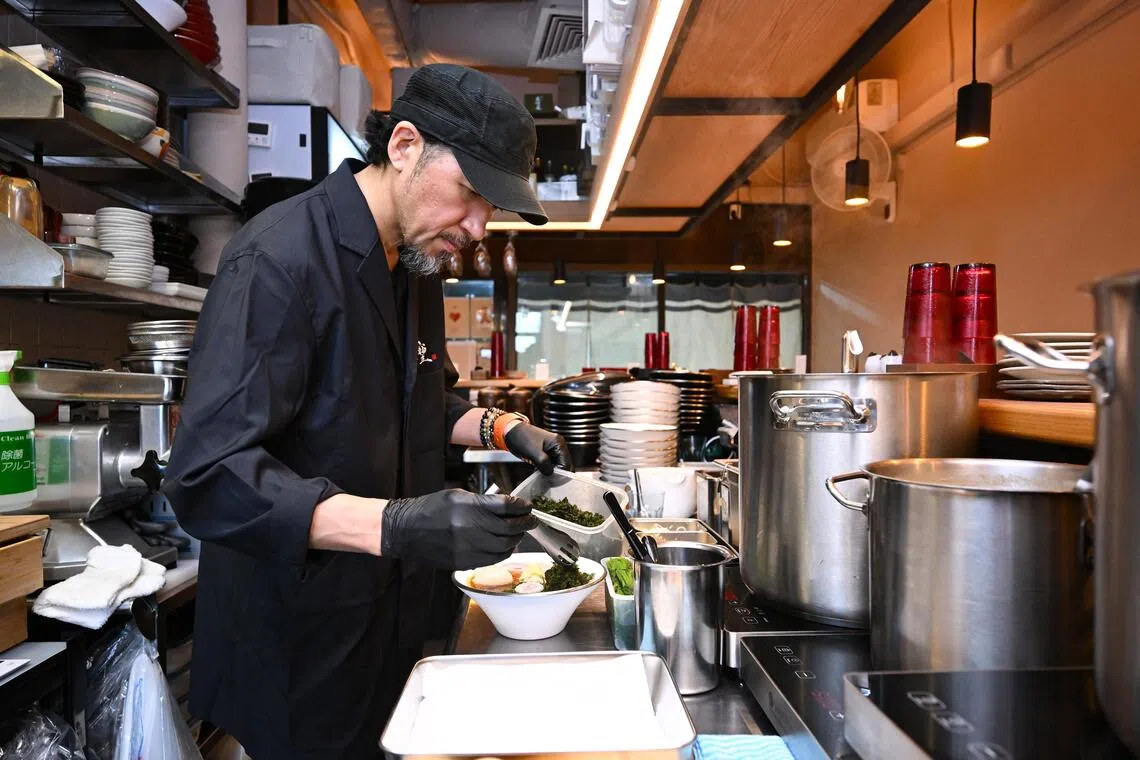
Chef Takashi Hashimoto, who co-owns Ramen Soshiji, takes pride in preparing housemade sauces and braised pork belly.
ST PHOTO: LIM YAOHUI
He took it as a challenge, creating a different ramen each week for more than a year. Encouraged by his regulars, he opened 12-seat Ramen Soshiji in August with two partners, bringing the flavours of Niigata and beyond to Orchard Plaza.
Customers start queuing 45 minutes before it opens for lunch and dinner. To serve more diners, the team has taken over another unit two doors down, which will add 16 seats when it opens in mid-November.
The top pick is the Ginger Shoyu Ramen With Special Topping ($19.60+), a speciality of Nagaoka City in Niigata. Ginger is used in three ways. It is added to a clear pork stock simmered with white onion and leek, infused into a house blend of three types of shoyu infused with dried shiitake and kombu, and freshly grated over the finished bowl.
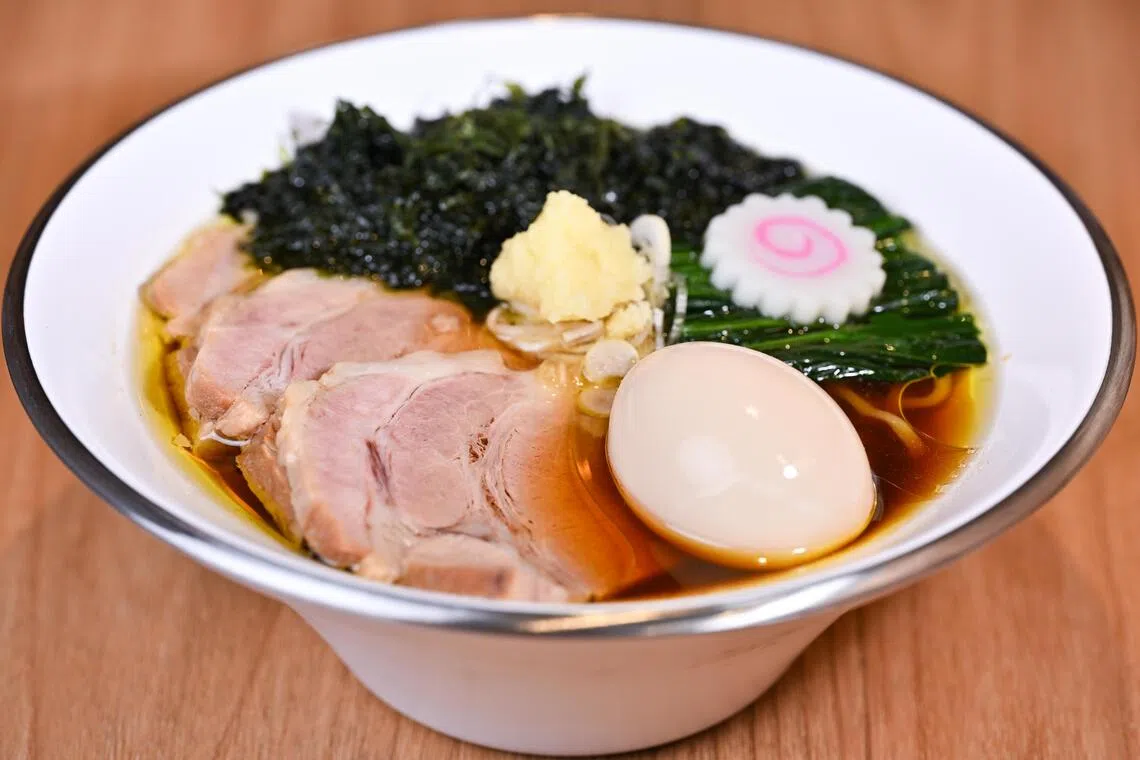
Ginger Shoyu Ramen With Special Topping at Ramen Soshiji is a speciality of Nagaoka City in Niigata.
ST PHOTO: LIM YAOHUI
For a more familiar option, go for Hakata Tonkotsu Ramen With Special Topping ($17.60+). Thin straight noodles come in a creamy, cloudy pork bone broth. A housemade sweet and spicy red sauce adds depth. Diners can choose from three spice levels: less, normal or more.
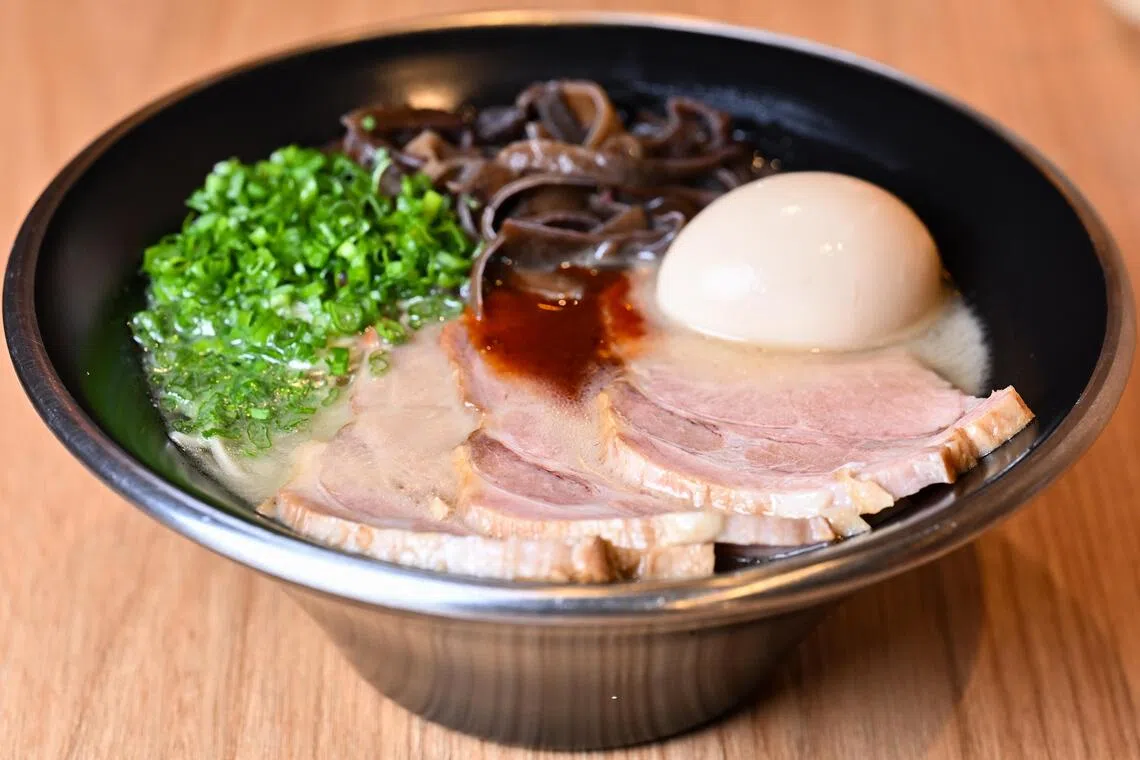
Hakata Tonkotsu Ramen With Special Topping at Ramen Soshiji features thin straight noodles in pork bone broth.
ST PHOTO: LIM YAOHUI
Mensho X @ Weave at Resorts World Sentosa: Modern ramen with respect for tradition
Where: 02-206 Weave at Resorts World Sentosa, 26 Sentosa Gateway @menshox_sg
Open: 11am to 10pm daily
Info:
Mensho X’s second outlet, which seats 48, opens officially on Nov 1 at Weave at Resorts World Sentosa.

Mensho X @ Weave at Resorts World Sentosa is the ramen brand's second outlet.
PHOTO: MENSHO X
Founded by Japanese ramen master chef Tomoharu Shono, 45, the brand is a fast-casual offshoot of Mensho Tokyo at Raffles City, which specialises in wholewheat, stone-milled noodles and a hearty chicken-based toripaitan broth.
Both brands in Singapore are a partnership between local food and beverage and lifestyle group Surrey Hills Holdings and Mensho Tokyo in Japan.
Mensho X features three variations of noodles – ramen (which uses a finer, softer flour for a smooth, delicate texture), tsukemen (made from high-protein flour resulting in a thicker chewier bite) and mazemen (which is designed to hold sauce well without becoming soggy) – each crafted with a unique flour blend for a distinct texture and flavour. It also offers a lighter version of the toripaitan broth, infused with kelp, shiitake and porcini mushrooms.
“Instead of making ramen heavier, we focus on clarity and depth of flavour, using premium natural ingredients like kelp, shiitake and porcini,” says chef Shono. “Our goal is to express modern Japan – clean, elegant and globally conscious – while keeping the soul of traditional ramen intact.”
The outlet at Weave introduces dishes exclusive to the location. The Wagyu Tantan Mochimen ($26++) features a new noodle type that chef Shono developed called mochimen, known for its soft, chewy texture. The noodles are tossed with a housemade sesame paste and smoked nuts for a rich, nutty finish.

Wagyu Tantan Mochimen is a new dish at Mensho X @ Weave at Resorts World Sentosa.
PHOTO: MENSHO X
Also exclusive is the Yuzu Shio Ramen ($23++), in which thin noodles are served in a delicate broth of bonito, clam and pork layered with chicken stock. The flavours are light yet complex, finished with a touch of fragrant yuzu.
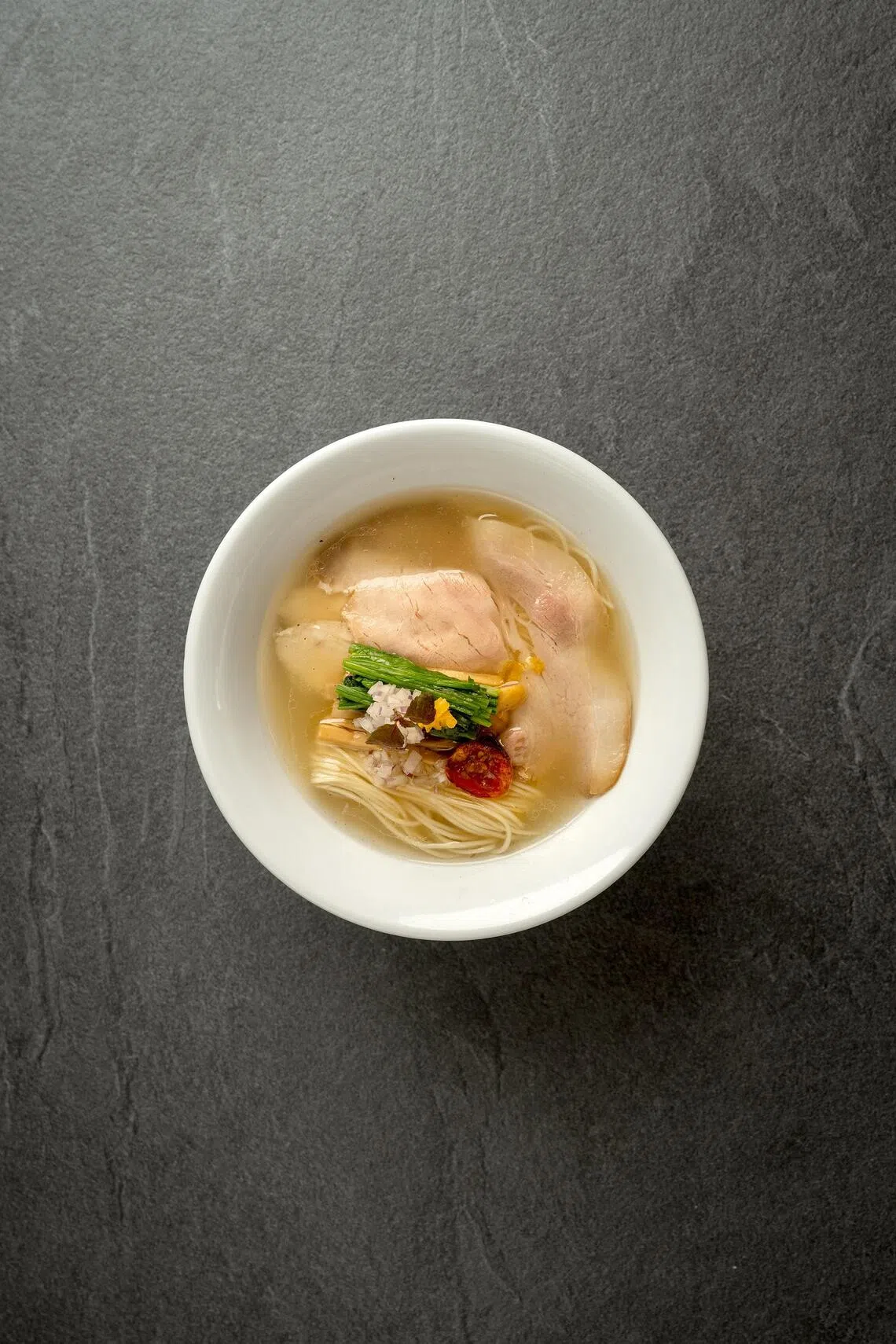
Yuzu Shio Ramen is a new ramen dish exclusive to Mensho X @ Weave at Resorts World Sentosa.
PHOTO: MENSHO X
Sanpoutei Ramen: Sardine-based shoyu broth
Where: B1-47 Paragon Shopping Centre, 290 Orchard Road sanpoutei.sg
Open: 11.30am to 9.30pm (Sundays to Thursdays), 11.30am to 10pm (Fridays and Saturdays)
Info: Call 6312-2210; go to
Sanpoutei’s third Singapore outpost opened at Paragon in May 2025. Founded in Niigata in 1967, the ramen brand made its Singapore debut in Holland Village in 2014, followed by a Shaw House branch later that year. Owned by Sanpo Group, the chain has 47 outlets in Japan and one franchise outlet in Canada.
The new 1,130 sq ft Paragon space seats 44 and features a bright, open look. Unlike the other two outlets, which are Niigata-themed, the Paragon outlet draws inspiration from Mount Fuji to express Japan’s attention to detail and craftsmanship.
Mr Kaneko Hironobu, 57, Sanpo Group president and Sanpoutei Ramen Singapore chief executive, says that while tonkotsu ramen gained worldwide popularity, Sanpoutei chose to focus on Japanese dried-sardine shoyu ramen.
The signature broth is simmered for seven hours with two types of dried Japanese sardines – katakuchi niboshi and urume niboshi – along with chicken and pork bones, then finished with Kotoyo soya sauce from Niigata. To preserve purity of flavour, the sardines are shipped in special anti-oxidation packs.
Noodles are made in-house daily for the ideal texture and bite, though the Paragon outlet receives its supply of freshly made noodles from the other outlets due to space constraints.
The Paragon branch also offers exclusive pork- and lard-free options, such as Tori Ramen With Karaage ($17++), served in a smooth, concentrated chicken broth topped with two pieces of deep-fried chicken.

Tori Ramen With Karaage, which is free of pork and lard, is exclusive to Sanpoutei Ramen’s newest outlet at Paragon.
PHOTO: SANPOUTEI RAMEN
The top pick remains the Niigata Shoyu Ramen With Flavoured Soft-Boiled Egg ($15++), featuring housemade flat noodles in a clear, savoury shoyu broth steeped in sardine richness.
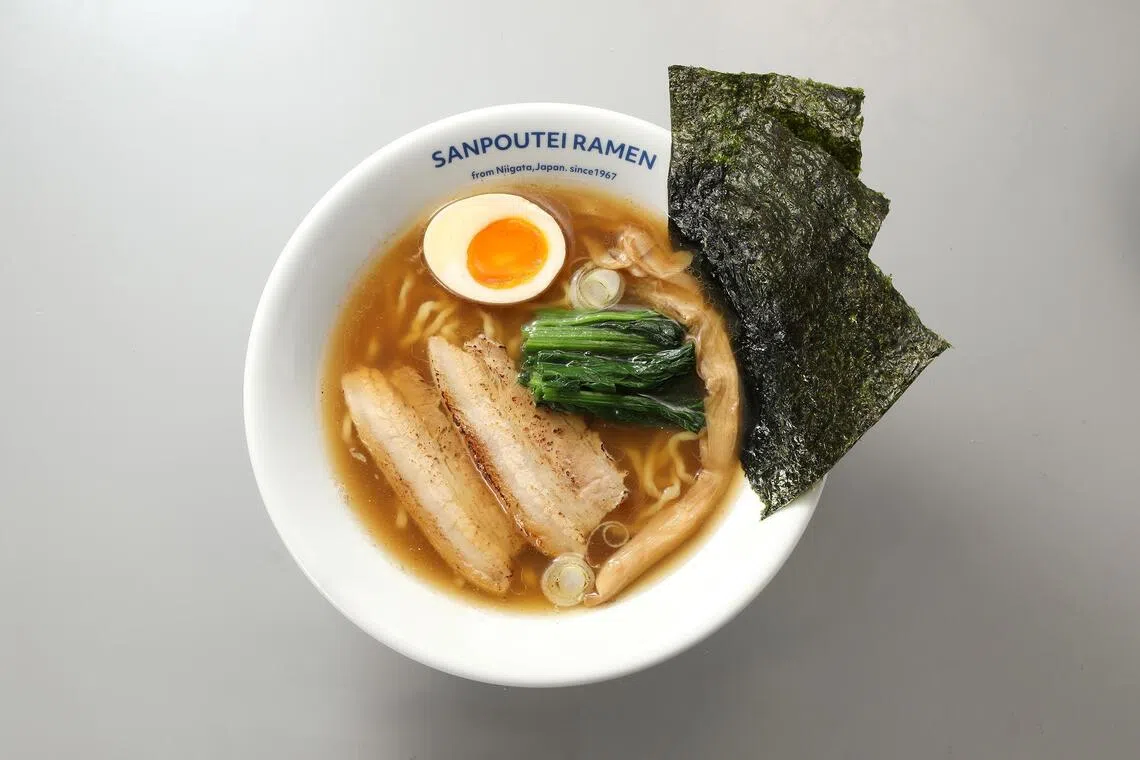
Niigata Shoyu Ramen With Flavoured Soft-Boiled Egg at Sanpoutei Ramen's Paragon outlet.
PHOTO: SANPOUTEI RAMEN
Ramen Story By Jinggho Shokudo: A local spin on ramen
Where: 04-27 Fortune Centre, 190 Middle Road @ramenstory_byjingghoshokudo
Open: 11am to 8.45pm daily
Info: Call 8962-9456;
Despite running a fast-casual eatery tucked on the fourth floor of Fortune Centre, co-owner and chef Alexander Kong, 34, has no qualms using premium ingredients from Japan, including black garlic oil, yuzu peel and ito togarashi (Japanese chilli threads).
However, he makes no pretence that his style of ramen is authentically Japanese, describing it instead as Singaporean-style ramen that is familiar, flavourful and approachable.
His ramen takes a fusion-style approach rooted in Japanese technique but adapted for local tastes. The soup base is a freshly made chicken paitan broth simmered for five hours, with no added monosodium glutamate.
Diners can choose between two types of noodles – traditional ramen and a flat, curly version resembling mee pok – made locally with Japanese wheat flour.
The new 24-seat outlet is an offshoot of his Jinggho Shokudo stall, which offers Japanese fare with local flair at hawker prices at Yishun Park Hawker Centre.
Born in Kampar, Perak, Mr Kong came to Singapore at 18 and started out as a kitchen helper at Ajisen Ramen in 2008 before rising to kitchen leader. He later honed his craft at several restaurants, including Konjiki Hototogisu, before striking out on his own.
“I’ve always wanted to run my own ramen eatery since my 20s,” he says. “Finally this year, I found the right partners.”
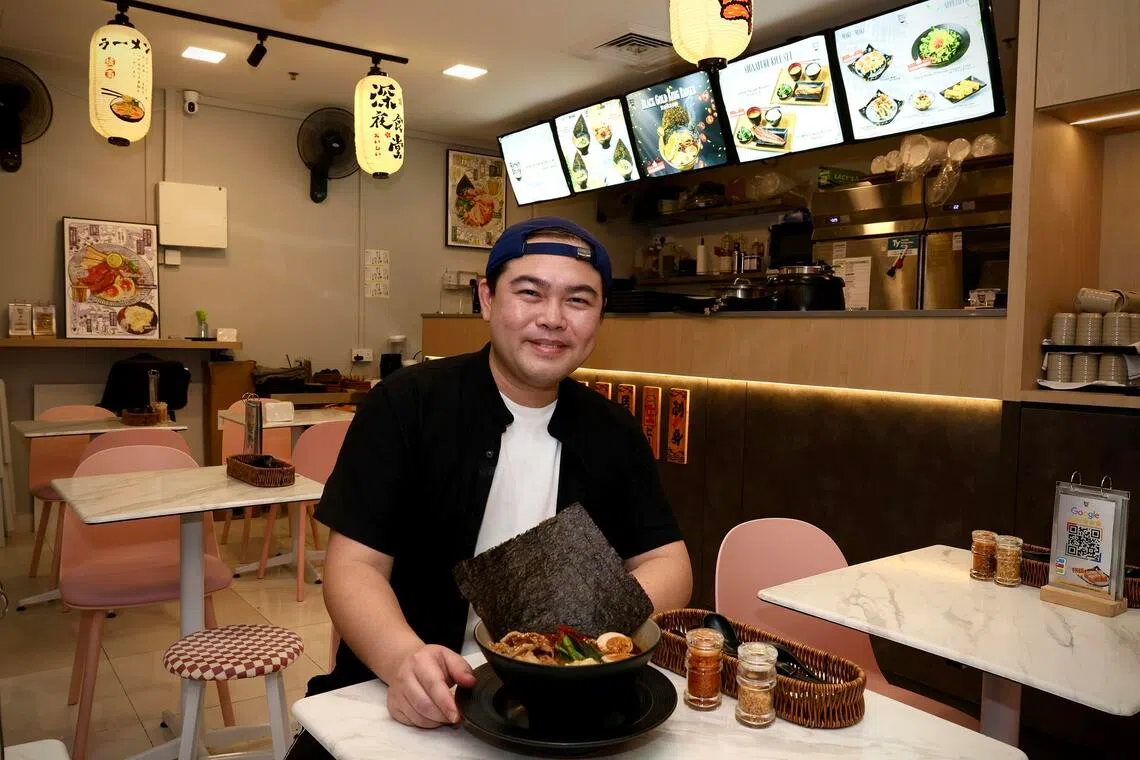
Mr Alexander Kong, co-owner and chef of Ramen Story By Jinggho Shokudo, with a bowl of the eatery’s signature Black Gold King Ramen.
ST PHOTO: HEDY KHOO
The Black Gold King Ramen ($20.90+) is the most popular dish. The dark, richly flavoured broth owes its colour and aroma to imported black garlic oil. The fermented garlic used to make the oil imparts a bitter edge, which Mr Kong balances with a touch of housemade chilli paste.
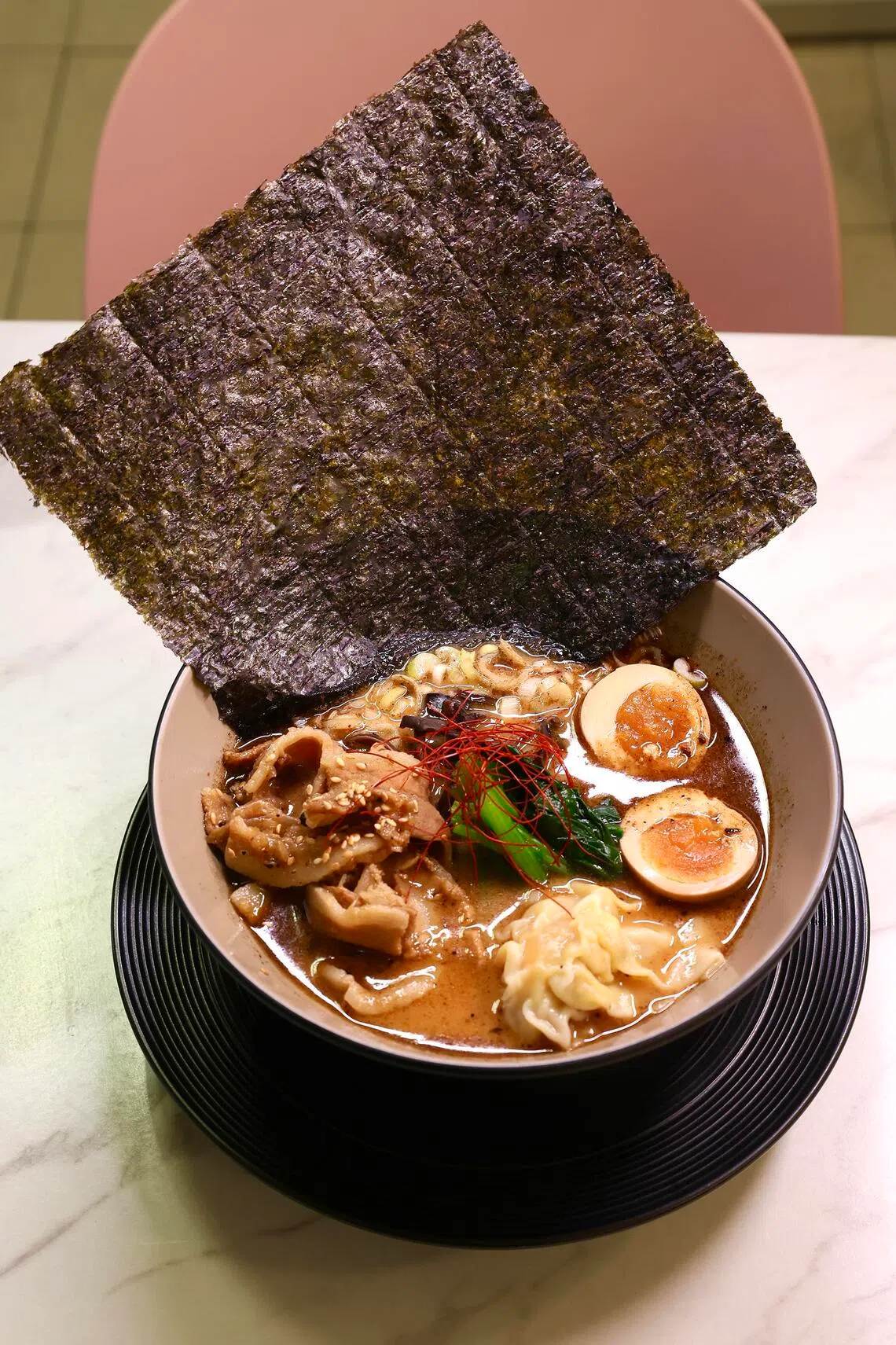
Black Gold King Ramen is the most popular dish at Ramen Story By Jinggho Shokudo.
ST PHOTO: HEDY KHOO
For something lighter, try the Yuzu Ramen ($13.90+), a refreshing variation accented with imported yuzu juice and peel.

Yuzu Ramen at Ramen Story By Jinggho Shokudo.
ST PHOTO: HEDY KHOO
Uma Haus: Japanese-inspired ramen in a hawker centre
Where: 02-118 Chinatown Complex, 335 Smith Street @uma_haus
Open: 10.30am to 8pm, Mondays to Thursdays, and Saturdays; 10.30am to 6pm, Fridays; closed on Sundays
Info: Call 9777-7696;
Former restaurant head chef Tang Gim Meng, 54, turned adversity into opportunity when he opened Uma Haus at Chinatown Complex in July 2025. After the sudden closure of his workplace, Senshi Sushi and Grill, he decided to start over as a hawker – focusing on ramen, the dish he loves most.

Mr Tang Gim Meng, owner of hawker stall Uma Haus.
ST PHOTO: HEDY KHOO
“I wanted to provide quality Japanese food to diners without them having to step into a restaurant,” says Mr Tang, who began his career in the 1990s working at Japanese restaurants and ramen joints, where he learnt to prepare stock, ramen eggs and chashu.
His stall name reflects his philosophy. Uma means “delicious” in Japanese, while Haus in German signifies “home” – together, a home of deliciousness.
With more than 20 years of experience in Japanese cuisine, he now channels his expertise into accessible bowls of ramen for everyday diners.
His stall focuses on ramen served with pork bone broth, with choices of different proteins. The bestseller is Signature Tonkotsu Ramen ($6.90). The pork-bone broth is simmered for up to seven hours until creamy and full-bodied, paired with thin ramen noodles, three slices of chashu and half a ramen egg. The chashu is braised weekly in a mix of mirin, cooking sake, a blend of Yamasa and Kikkoman shoyu, and sugar over low heat for five hours.
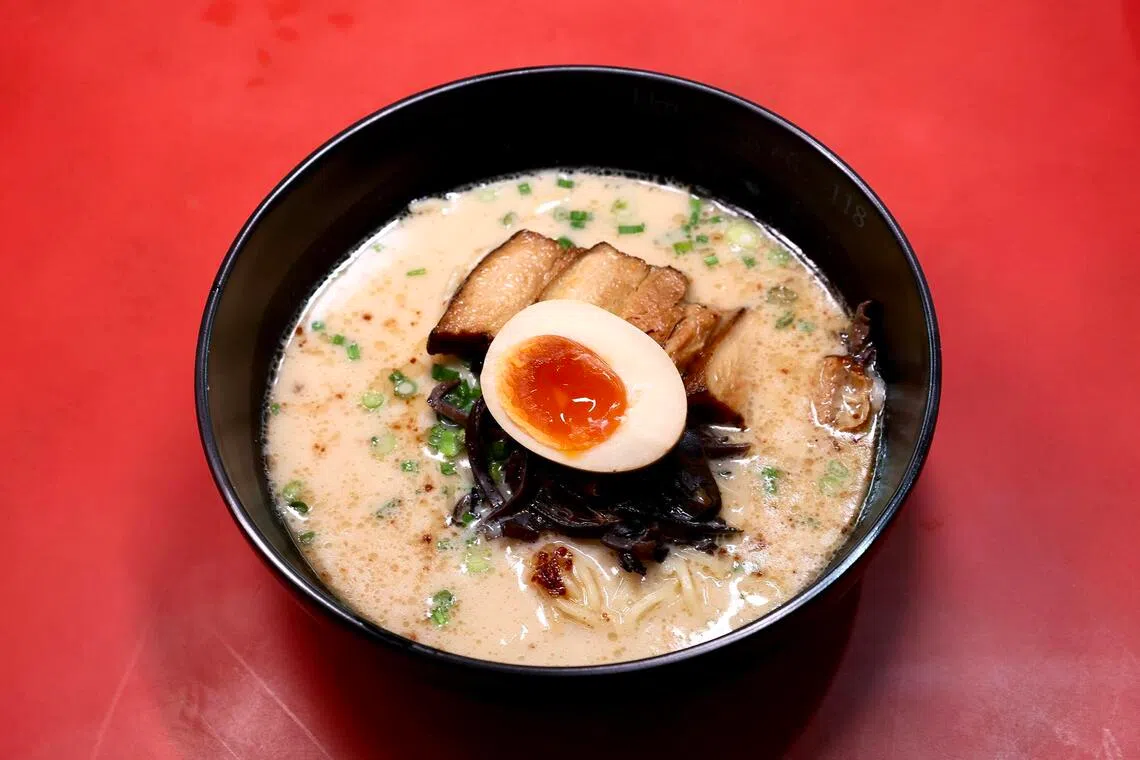
Signature Tonkotsu Ramen is hawker stall Uma Haus’ bestseller.
ST PHOTO: HEDY KHOO
For something lighter, the Abura Dry Ramen ($3.90) is tossed in housemade shallot oil with minced pork, ginger and garlic, then topped with crispy shallots and spring onions. Each portion comes with a small bowl of tonkotsu broth on the side. Diners can order sides to go with their ramen, such as Black Tiger Prawn Tempura ($4.90), prepared from scratch daily using Japanese tempura flour.
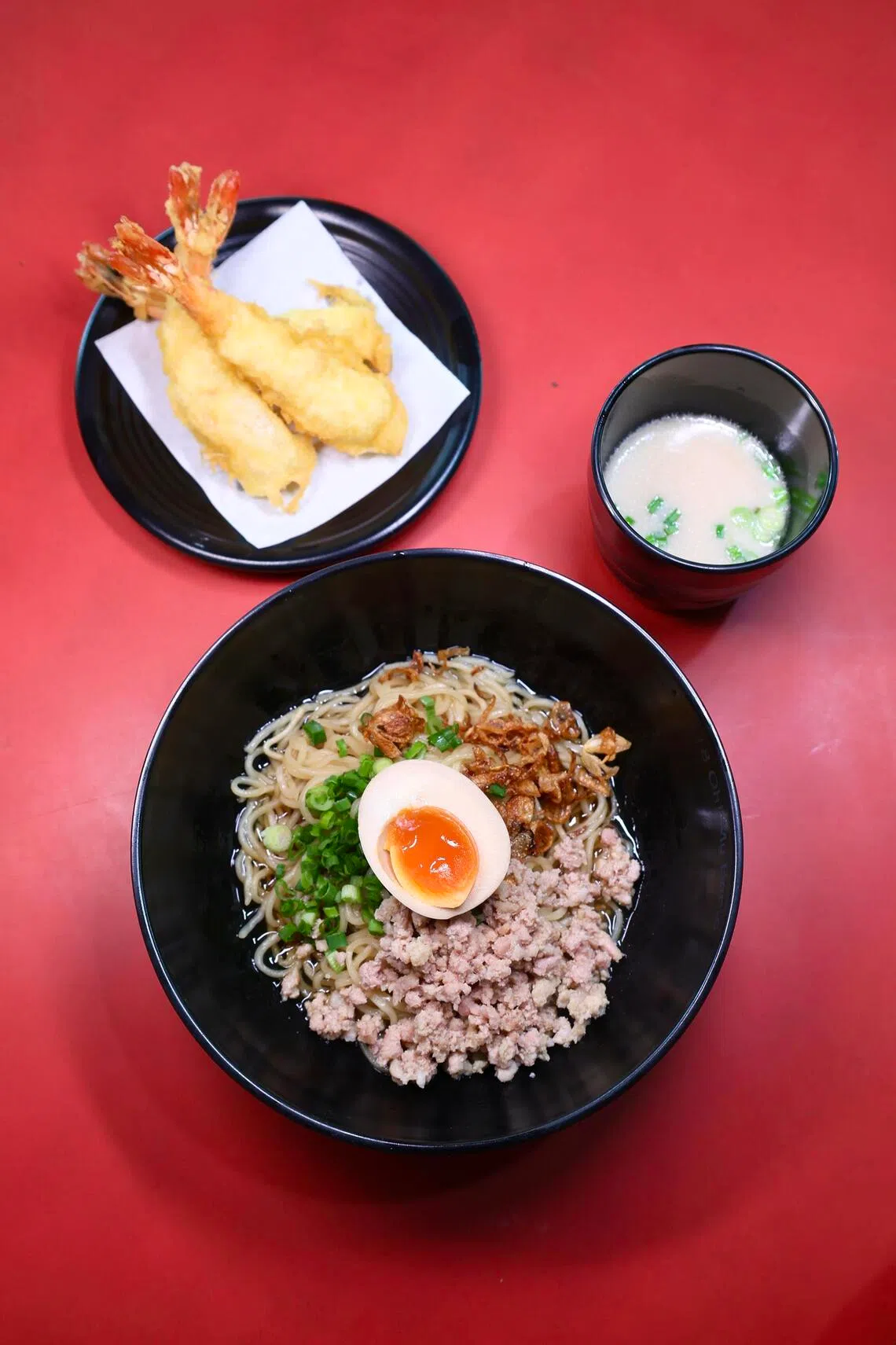
Abura Dry Ramen with an additional order of Black Tiger Prawn Tempura at hawker stall Uma Haus.
ST PHOTO: HEDY KHOO
For takeaway orders, Mr Tang takes care to undercook the noodles slightly so that they retain their springiness.
“Ramen is my comfort food,” he says. “I eat it four times a week myself. At the end of the day, I’m cooking what I love for customers who appreciate good food at fair prices.”


